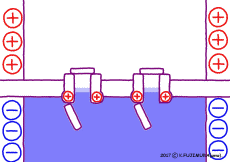[055] Voltage-dependent sodium channel (rev) (GB#113A02B) | 基礎医学教育研究会(KIKKEN)Lab

Although this site has not yet accessed as a whole, in that time (2017), ‘[024] voltage – dependent sodium channel ‘ page access somehow protruding. Very thankfully, on the other hand, there has been a part that is not accurate in the part of animation, and it is uncomfortable to leave it alone for the time being (is there an “accuracy” in the animation of this site in the first place? (^ ^)), so I finally decided to redraw back after four years.
However, it is a story of details, so people who do not mind the difference can be skipped. Nevertheless the voltage-dependent sodium channel animation of this page is the latest version (revised version).
Contents
● The switch of the channel is positive (apparent)
In the voltage-dependent channel, the specific part with electricity in the molecule moves according to the potential difference inside and outside the cell membrane in which the channel is embedded. That is the switch to open and close the gate. The principle is simple, the same polarity repel each other, different polarities attract each other. In the previous version of the page [024], I was thinking that the actual situation would not be understood well, so I assumed that this switch was a particle with a negative charge and drawn animation. However, when examined afterwards, although information was not yet found in the sodium channel, it seems that there is almost no doubt that at least in the voltage-dependent potassium channel, the gate is a positively charged particle ( Gate / Brain Science Dictionary ) . (To be precise, the potential sensor for moving the gate is positive particles.)
So in the picture of the sodium channel, using the known information, for the time being, the gate switch should be drawn with positively charged particles. So, the revised latest version is the animation of this page.

Since negatively charged particles are replaced by positively charged particles, the movement of the particles with respect to the membrane potential is opposite to that of the case of negative charged particles. With negative resting membrane potential inside the cell, the switch faces inward and moves outward when depolarized.
In addition, the movement of the switch, the timing of opening and closing the gate, and the movement of the ion are slightly revised. Nonetheless, there are few people who are aware of this, even if they look at it.
○ Referenced site
· Gate / Brain Science Dictionary (2013/8)
· voltage-dependent channel/ Brain Science Dictionary
· Voltage Gated Sodium Channels / University of Washington
○ Related articles
◆[024] Voltage-dependent sodium channel ![]()
◆[021] Action potential ![]()
◆[031] 興奮伝導 conduction of excitation ![]()
◆[028] Resting membrane potential ![]()
◆[036] Ligand-gated ion channel ![]()
◆[040] シナプス伝達 neural signal transmission ![]()
◆[044] 伸張反射 stretch reflex ![]()
◆[013] 細胞膜の脂質二重層 lipid bilayer of the cell membrane ![]()
◆[004] 陽イオンと陰イオン(1)引力と反発力,cation and anion, attraction and repulsion ![]()
◆[019] アデノシン三リン酸(ATP) adenosine triphosphate ![]()
○ Referenced books
・臓単―ギリシャ語・ラテン語 (語源から覚える解剖学英単語集 (内臓編))
・カラー図解 人体の正常構造と機能 全10巻縮刷版,坂井 建雄,日本医事新報社
・人体機能生理学,杉 晴夫,南江堂
・細胞の分子生物学, ニュートンプレス; 第5版 (2010/01)
・トートラ人体解剖生理学 原書8版,丸善
・イラスト解剖学,松村 讓兒,中外医学社
・柔道整復学校協会編「生理学」,南江堂
・東洋療法学校協会編「生理学」,医歯薬出版株式会社
rev.20171222, rev.20171223, rev.20171227, rev.20180105, rev.20180106, rev.20180228, rev.20190928.
KISO-IGAKU-KYOIKU-KENKYUKAI(KIKKEN)








